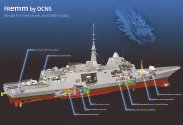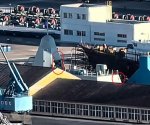You are using an out of date browser. It may not display this or other websites correctly.
You should upgrade or use an alternative browser.
You should upgrade or use an alternative browser.
Corvette/Light frigate thread (056A, sub-4000t FFLs)
- Thread starter Blitzo
- Start date
That’s for the GT.the FREMM appears to have a top exhaust.
After giving some thoughts on the matter - What is the viability for platforms like this new FFL as "loyal wingman"-type minimally-manned or optionally-manned warship or UCSV that have comparable speed and endurance as the larger warships of the PLAN?I honestly thought all the argument for why this thing does not fit into current PLAN fleet composition and how PLAN has abandoned "small ship big gun" thing were pretty convincing, but the thing that made me not 100% convince was actually the colour.
A photo from the launch ceremony of the stealth frigate has emerged. The banner refers to this ship as 综合试验平台/Integrated Test Platform, so likely it is indeed for PLAN and not for export.
Is "integration test platform" not a better translation? Google lists 综合 as a noun, verb and an adjective with several interpretations while 试验 is just noun and verb for "test".
As unnatural as it sounds in English the first translation of "comprehensive test platform" fits it even better semantically and matches what I see on the image.
Based on what I know of naval design this vessel looks built for the purpose of testing of integration of sub-systems in a specific type of hull which would explain why the hull is so unique and unusual for PLAN vessels that we know. With the exception of Fujian which I haven't analysed all PLAN vessels have extremely conservative design approach. This breaks all the rules.
--------
1. Comprehensive VLO shaping of the hull.
Design is consistent - including the bow gun - with few exceptions like the SAM launcher above the presumed hangar, but this element can be easily accounted for in testing, and may even play a role as a reflector. This is clearly not an experimental ship like Smygge or SeaShadow but it is far in excess of what PLAN demonstrated so far.
2. Presumed hangar placed closely to the bridge and conspicuous lack of vertical exhausts.
This is a challenge in terms of both solving the internal layouts in terms of reliability, functionality and security/survivability as well as in terms of balancing the ship. The hull seems typical for the Soviet-style ~500-1000t displacement missile corvettes like Molnya/Tarantul, Ovod/Nanuchka, Buyan or Karakurt which is unstable at both higher sea states and at lower speed regardless of size.
A similar problem was encountered by Sweden with the Visby project in the 1990s but Visby is designed as a coastal ship on purpose. Sweden has one of the world's most complex coasts with the highest number of islands: 267 570 islands vs Japan's 120 729 or China's 6 961. Norway and Finland are 2nd and 3rd with 239k and 179k respectively. For Visby stability at low speeds was resolved mechanically. Soviet Molnya/Tarantul on the other hand spared the cost and as result had horrible handling at lower speeds <15 knots because they were designed for top speed performance of 30-40kt.
Note that Visby has no hangar just the landing pad for emergencies but this ship seems to have hangar for at least large UAV like Meko A100/Braunschweig corvette of German Navy which can land only small helicopter but carries two camcopters internally. Stability is the most fundamental issue for launching and recovery of aircraft of any type.
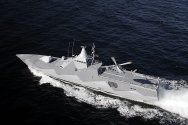
3. Small integrated sensor mast.
Integrated masts are not easy to build, especially at this size. Cooling is a problem and water cooling introduces mass at height which reduces stability. First Karakurt which has an integrated mast was only laid down in December of 2015 after testing simpler, traditional solutions with Buyan (2004) and Buyan-M (2010) and I estimate that the mass in Karakurt's mast is lower than here.
4. No visible solutions for surface/undersea unmanned systems deployment.
No future-proofed multirole warship, especially for coastal operations, is viable without them and any actual prototype must have them for testing as well.
-------
From what I can surmise from the few images that we have available is that it is a design closer to Visby with hangar than to other superficially similar vessels like Kership or 20386 or others - and that poses a challenge in multiple domains. Sweden had excellent engineering so they were able to solve them but still at a cost and adding the hangar here is significantly increasing complexity.
Now the final fundamental factor is cost and ease of construction which is better for larger vessels: hull is cheapest part of modern warships and achieving functional solutions including VLO is cheaper with larger hulls.
Small hulls have a single explanation: port infrastructure. Israel is building small vessels (Sa'ar 5, Sa'ar 6) because it doesn't have ports for larger ones. Sweden was building small vessels because they were meant to operate in coastal and inland waters. Etc. No country at present builds a smaller ship than it absolutely needs to because it's counter-productive.
Therefore until someone manages to plausibly gauge the actual size of this ship (Corvette/Light frigate thread (056A, sub-4000t FFLs) is insufficient without second sample) we may assume it's a one-off test vessel because a 2000-2500t with 97m is just above the Type 056A (90m, 1500t) and A100 (90m, 1900t) neither of which carries a helo which is in my view a problem for any future design, especially one focused on ASW.
1.For testing extreme conditions are better i.e. smaller (challenging) hull.
2.For building and use greater safety margin are better i.e. larger (convenient) hull.
We have to wait for more information to draw conclusions. Currently I see no reason why PLAN would invest in such design for other purposes. The payoff is not there and cost is substantial. But the benefits of practical testing of all the solutions and technologies I mentioned is enormous because this particular hull type lends itself to adaptation into some very potent platforms - just not at this size. And testing of several novel solutions at once has the added benefit of testing the ability to integrate several novel solutions at once.
I honestly thought all the argument for why this thing does not fit into current PLAN fleet composition and how PLAN has abandoned "small ship big gun" thing were pretty convincing, but the thing that made me not 100% convince was actually the colour.
"Small hull, big gun" is a purely defensive, coastal or desperation measure and was rightly abandoned by PLAN. Soviets used it because their doctrine did not assume any significant power projection at sea, just baseline "A2/AD". Russian ship design in the 2000-2020 period is pure desperation stemming from their inability to field modern large surface combatants wrapped in typical Russian hyperbolic propaganda.
After giving some thoughts on the matter - What is the viability for platforms like this new FFL as "loyal wingman"-type minimally-manned or optionally-manned warship or UCSV that have comparable speed and endurance as the larger warships of the PLAN?
Excessively expensive and with insufficient sea-keeping to follow any green/blue-water task force.
The optimal design is a simple, robust utility-type multifunctional hull with containerised payloads similar to the type of ship that services offshore drilling installations.
See LUSV:
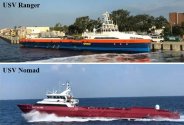
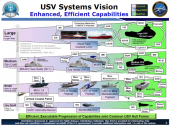
This is how command/sensor/weapon roles are assigned:
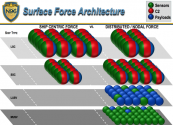
The environment (domain) determines the nature of the engagement therefore naval surface engagements obeys rules of ground warfare while naval undersea warfare has similar rules to aerial combat. Salvaging a damaged surface warship is viable much like salvaging a tank or infantry position. Not when it comes to damaged submarines or aircraft. Therefore VLO for surface and undersea tactics will be different: sleek design for submarines and crude cope cages for surface warships.
VLO matters most where there is no survivability in damaged state. Surface at sea is dangerous but offers plenty of survivability. The last diagram demonstrates that investing in smaller less capable "decision/multirole nodes" is counter-productive. So this design may be applied - at least in part - to primary larger vessels. It's wasted on secondary or smaller ones which benefit from being able to fulfill wider array of roles , esp. in peacetime.
Last edited:
热烈庆祝海军舰船综合全电力推进系统项目试验平台下水.it should be 热烈庆祝XXXX综合XXXXXX项目试验平台下水,translate to celebrate xxxx comprehensive xxxxxxx project experiment platform launch
just kidding.

